CBA North Home Front Legacy Day School Monday, August 10th, 2015
|
|
|
|
|
The Cocken Hall CBA North Home Front Legacy Day School is being held this Saturday 15th of August 2015 at Palace Green Library in Durham, DH1 3RN.
The event is free but you need to register at https://www.eventbrite.co.uk/e/cba-north-home-front-legacy-day-school-tickets-17390607776
This day school will:
• Get you actively involved with the Home Front Legacy 1914–18 project
• Share the toolkit and resources to use within your own projects, or to start one up
• Enable you to start discovering your local First World War surviving sites, structures and buildings using online resources
• Help you connect with your local Historic Environment Record
• Give you the skills and confidence to share your learning with your community group
• Provide the forum to share your projects and to meet potential partners
Course delivery: presentation, multimedia and practical demonstration. Bring along your own laptop, tablet or mobile, if you have one, for our practical recording demonstration.
Day school programme
10.30 Welcome and coffee
11–12.15 Presentation, multimedia
1. An introduction to the Home Front Legacy 1914-18 project
2. What remains are out there? First World War surviving physical remains overview Land, Sea, Air, Home Front:- Key Note Speaker Roger Thomas Assistant Designation Adviser (North) in Historic England’s Northern Designation Team, based at York.
3. Local Case Study – Excavations at Cocken Hall 2015:- Alistair Fraser Assistant Librarian (Early Printed Books) Archives and Special Collections Durham University Library
12.15–1pm Presentation, practical demonstration
Local Case Study – Durham at War Victoria Oxberry, Collections Access Officer, Durham at War.
4. Getting started – step by step to setting up and taking forward your recording project
Desk Research: How do you find WWI remains?
• The Heritage Gateway
• What are Historic Environment Records (HERs)?
• How do they help local groups?
• How do they protect your local historic environment?
• What services can you access?
• Questions for HER Officers
Other sources of information – online
• The National Archive
• Commonwealth War Graves Commission
• Genealogical web sites
• Local historical records, museums and archives
• Great War Forum
• War Memorials Online
• National Monuments Records
• Arts and Humanities Research Council Connected Communities First World War hubs
• Heritage Lottery Fund ‘Then and Now’
Networking lunch 1–2pm
2pm–3.45 Presentation, practical demonstration
5. Using the site recording toolkit
• Finding sites with maps and aerial photographs
• Field recording using the app
• Site recording demonstration from using the web resources to completing the app recording form and displaying your site and project on the online map of UK remains
• Writing site descriptions
• Local case studies
3.45–4pm Q&As Get involved/contacts and close.
|
|
|
|
|
|
Filed under: Conferences & Lectures, The Cocken Hall Project by
Cocken Hall Team
Add a Comment »
|
|
Day 6 Friday, June 26th, 2015
|
|
|
|
|
Today we have had a visit from our partners at the Durham Record Office, the local press and TV. Work is progressing well, the area around our mystery concrete block is slowly being revealed, work on the rifle range area has revealed a hard packed earth floor.
.
Trench 3 revealed some fragments of beautifully painted plasterwork and two electical conduits, in trench 4 we have located the return on the wall of the cobbled yard and finds include broken glass bottles and kitchen ware. On the long narrow rear wing of the house, Jon’s team have lifted a section of fallen wall, revealing that it had fallen outwards into a grass covered area and on the other side they have an interior floor surface with a row of large flag stones and brick, outside there is a cobbled surface very similar to the yard in trench 4.
|
|
|
|
|
|
Filed under: The Cocken Hall Project by
Cocken Hall Team
Add a Comment »
|
|
Day 5 Thursday, June 25th, 2015
|
|
|
|
|
Today we have had a 3D scanner on site, recording our excavations and the remaining hut bases, the occasional showers have slowed progress as we are unable to use the equipment in the rain.
.
Progress on the trenches has been steady, mainly cleaning in preparation for the scanning. In trench 4 we have located the steps leading down to the cellar and in trench 3 an earlier floor surface. Finds have been mainly domestic with a halfpenny dated 1899. In the woods we have been clearing the vegitation and working out the function of the various huts. The minature rifle range is proving illusive in respect of locating the walls, but we have found a compacted surface which could be the earth floor of the rifle range.
.
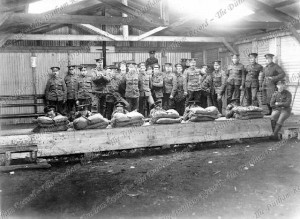
18th DLI on the Minature Rifle Range at Cocken Hall.
|
|
|
|
|
|
Filed under: The Cocken Hall Project by
Cocken Hall Team
Add a Comment »
|
|
Day 4 Wednesday, June 24th, 2015
|
|
|
|
|
Wednesday already and suddenly the site is making more sense. In trench 3 we have discovered a window from an earlier phase of the house, the landscaping has lifted the ground level and concealed beneath is the earlier building. We have also found some painted plaster and the remains of the fire place.
.
Trench 4 has also made good progress, the return of the southern wing in the cobbled yard has been located and there may be a drain the the corner which is yielding a lot of broken glass. The small room has steps leading down, possibly to the cellar?
.
In our hunt for traces of the Durham Pals, we have cleared some of the undergrowth from the remaining hut foundations. By matching the historic records to the remains on the ground, it appears we have four drying rooms, one for each company, the building which is shown in one of the contemporary photographs. Behind it is the bathhouse and beyond that our mystery block of concrete on a concrete pad.
.
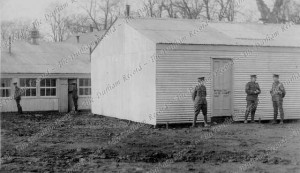
Exterior of Miniature Rifle Range & Drying Room at Cocken Hall.
.
|
|
|
|
|
|
Filed under: The Cocken Hall Project by
Cocken Hall Team
Add a Comment »
|
|
Day 3 Tuesday, June 23rd, 2015
|
|
|
|
|
Today the weather was much better, we have closed down trenches 1 and 2 as we have been unable to locate any sign of the training trenches dug by the 18th Battalion Durham light Infantry. In the woods, progress has been much better, with the team in trench 3 locating the door which is shown in several of the DLI collection photographs. Trench 4 have located the extent of the yard and traces of the wine cellar. We are also beginning to investigate the rear wing of the house and plot the traces of the hut bases.
|
|
|
|
|
|
Filed under: The Cocken Hall Project by
Cocken Hall Team
Add a Comment »
|
|
Day 2 Monday, June 22nd, 2015
|
|
|
|
|
This morning, in trench 1, Jon’s team continued to search for the illusive practice trenches, whilst in trench 2, Keith’s team recorded the single feature they had located yesterday, a post hole filled with clay, they then joined forces with Jon and trrench 2 has now been closed down. In trench 3 one wall of the house has been located and excavation is progressing well.
.
Trench 4 is the most interesting so far, with several walls of the house being located not far beneath the surface. Drainage from the bathroom has been identified and outside we have a cobbled court yard. Our Geophys team have surveyed another part of the field, the results clearly show a modern pipe, but will need to be processed to reveal any traces of the camp
.
Rain stopped play this afternoon and we were unable to continue, but the shortened day has allowed us to clean the finds we have so far, fragments of domestic pottery, nails, peices of pipe, glass and other structural debris. We have also found a few peices of clay pipe.
.
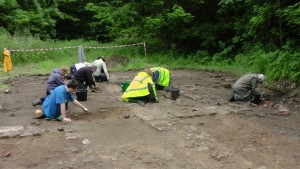
Trench 4
.
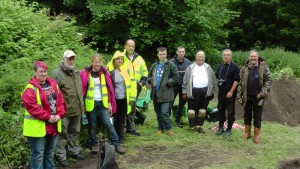
The team working on trench 4
.

Trench 4, excavating the wall of the house.
.
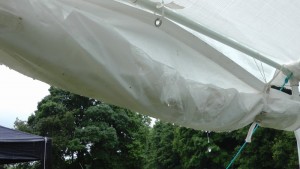
We are unable to continue in the rain as the ground is too slippery and it is difficult to trowel wet earth and keep it clean, the soil tends to turn to mud and obscure the archaeology.
.

One of our participants modeling the dig t-shirt.
.
|
|
|
|
|
|
Filed under: The Cocken Hall Project by
Cocken Hall Team
Add a Comment »
|
|
First Day at Cocken Hall Sunday, June 21st, 2015
|
|
|
|
|
Today was our first full day of excavation at Cocken Hall, we have opened four trenches all of which look possitive. On the site of the house, we have located several walls and some interior fixtures. In the training trenches area work is progressing with some features showing.
_
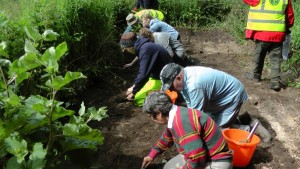 _ 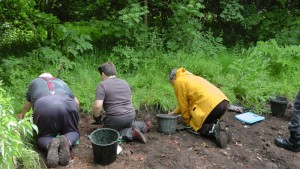
This afternoon we had a show and tell of the uniform and equipment used by the Durham Pals in training at Cocken Hall. Unlike most of Kitchener’s New Army, the 18th DLI, which were privately funded, receieved drab uniform quickly, rather than the unpopular temporary Kitchener’s Blue.
.
|
|
|
|
|
|
Filed under: The Cocken Hall Project by
Cocken Hall Team
Add a Comment »
|
|
The Cocken Hall Project Sunday, June 14th, 2015
|
|
|
|
|
We are pleased to announce that our next fieldwork will be taking place in the UK.
_
The Cocken Hall Project is an archaeological and research investigation being run by No-man’s-Land: the European Group for Great War Archaeology in partnership with Durham University’s Archives and Special Collections, the Durham County Record Office and the Northumbria Gardens Trust. It is supported by a generous grant of £10,000 from the Heritage Lottery Fund as well as support from local firms and organisations including Interserve, Turner and Townsend, Aldi, Framwellgate School and Framwellgate Scouts.
_
In 2011 one of NML’s members, Alastair Fraser, catalogued the papers of William Douglas Lowe, a classics lecturer at Durham University a catalogue of which is at https://www.dur.ac.uk/library/asc/collection_information/cldload/?collno=579. Lowe was a keen rower and also active in the Durham University Officers’ Training Corps in the years before the Great War.
_
On the outbreak of war Lowe joined the newly formed 18th Durham Light Infantry, the Durham Pals and was soon the Adjutant. The battalion was offered the use of Cocken Hall, a rather run down and unoccupied country house between Durham and Chester-le-Street. Initially the troops were accommodated in the house and its outbuildings but such was the pace of recruitment that the site quickly became overcrowded and contracts were let for the construction of huts. 18 DLI did their initial training on the site and moved to Cramlington in May 1915, then to Ripon in Yorkshire and later Fovant in Wiltshire. The whole of 31st Division were moved first to Egypt and then to France where one of 18 DLI’s companies was virtually wiped out on 1st July 1916. The battalion did another tour on the Somme over the winter of 1916/17 and fought at Arras. They spent the rest of the year in that sector and were fortunate enough to avoid the Third Battle of Ypres entirely. During the early days of the German offensive of March 1918 the commanding officer was wounded and Major W. D. Lowe came up to take command of the battalion. Losses were severe and the whole of 93rd Brigade was amalgamated into 93 Composite Battalion by the end of the month. The battalion did not become an independent formation again until 20th April. The division had moved to the Meteren area on the French/Belgian border and for much of the summer the battalion was involved in small scale actions attacking German outposts and defensive positions. It took part in the recapture of Ploegsteert Wood and ended the war with a crossing of the River Scheldt.
_
It was clear from the abundant material in the Lowe Collection that No-man’s-Land might be able to conduct an investigation similar to the “Plugstreet” Project, using archaeology and archive to throw light on how a British Pals Battalion trained and fought the Great War. Unusually much of the material related to training, much of it in the countryside around Cocken Hall. The Battalion is well documented and is the subject of two histories by W. D. Lowe and John Sheen and the Durham County Record Office has many memoirs and diaries of men who served in it. Additionally the Record Office has a superb set of photographs of the battalion under training at Cocken Hall, mostly taken by a press photographer from the Newcastle Evening Chronicle. Paradoxically Cocken Hall itself is not well known and excavation would be very useful to enhance understanding of the site.
_
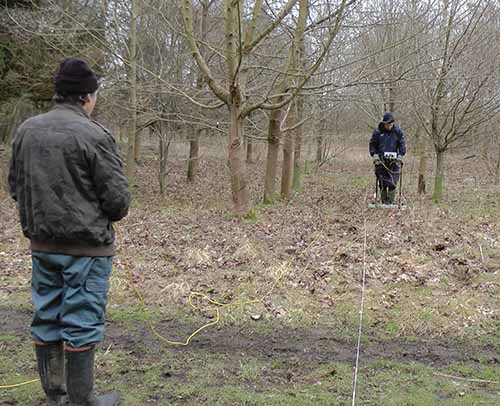
Survey at Cocken Hall
_ In February 2014 No-Man’s-Land members under the direction of Peter Masters undertook a programme of geophysical survey on the field in which most of the huts were situated. Hut foundations and post pads showed fairly clearly as did a series of drains probably associated with latrines. The main north/south wing of the house was also located.
_
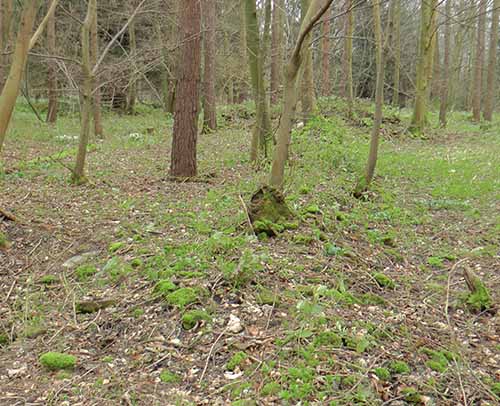
The Site of Cocken Hall.
_
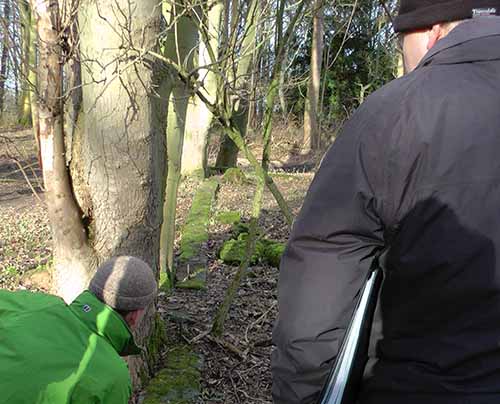
Foundations of a building in the WW1 Training Camp at Cocken Hall
_
Two photographs of troops digging a rather chaotic trench suggested that there had been some sort of trench system. Comparison of the photographs with the landscape located this trench and subsequent geophysical survey in February 2015 revealed a quite substantial trench system possibly including dugouts or machine gun posts. This is a target for excavation.
_
A systematic search of local archives is the second part of the project and volunteers are being sought for this. A lot of interesting material has come to light already and we hope to have more. _
All places on the excavation team have now been allocated, but you can assist with our research via our website at http://www.plugstreet-archaeology.com/cocken-hall/
|
|
|
|
|
|
Filed under: The Cocken Hall Project by
admin
Add a Comment »
|
|
|
|
|
|